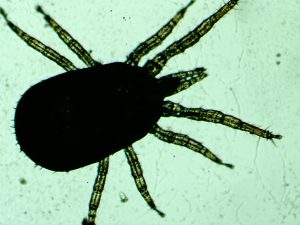A natural solution that contributes to the control of red mites

Red mites
The red mites’ lifestyle and consequences in animal production
Red mites (Dermanyssus gallinae) are a very common issue in laying hens, widely common worldwide. Europe has the worst prevalence rate, with nearly 90% of the farms affected.
Red mites grow quickly and they reach the adult stage in about ten days. They do not live permanently on the birds, they hide themselves in the recesses sheltered from the light then come to feed on the blood of their host when it is in the darkness. Red mites can take up to 3% of the bird’s blood in one day, causing anemia and increasing food consumption.
In the nymph stage, the red mites can easily survive 9 months without eating. Each adult may lay 21 eggs after a blood meal, which is therefore essential to allow reproduction. This is why, in case of uncontrolled infestation, the multiplication of red mites is exponential, with heavy consequences for poultry and their productivity. A heavily infested hen can house up to 250 000 red mites!
Beyond an increase in the Feed Conversion Rate, red mites are vectors of disease and cause chronic stress in hens that results in feather pecking between individuals. Result: a decrease in production parameters and an increase in mortality.
In poultry farms, red mites are also responsible for the degradation of the quality of the eggs (weight, resistance of the shells) but also the appearance of eggs stained with blood, which are then not marketable.
In Europe the cost caused by Dermanyssus gallinae exceeds 300 million euros each year with an average cost per hen of 0.50 € per hen in case of average infestation and which can exceed 2 € / hen in the more severe scenarios.
How to fight against red mites?
Several approaches exist to control the red mites’ infestation.
The most commonly used solutions are chemical, with the use of acaricide molecules. Although expensive, these methods are effective and allow a large reduction in populations. However, when they feel threatened, red mites secrete pheromones which allows them to form “clusters” by aggregating in order to increase their resistance. Thus, bioresistance phenomena have appeared in recent decades due to the massive use of these synthetic products.
A second means of control is silica and diatomaceous earth powder spraying to mechanically neutralize red mites. These methods are little used because technically difficult to implement and very expensive.
Finally, there is a third strategy, preventive and natural treatment : the use of aromatic plant extracts with repellent properties. When incorporated into food or water, the repellent compounds are secreted by the birds’ uropygial glands, which allows a change in their odor. As a result, red mites do not come to feed on the blood, and therefore can no longer reproduce.
This gentle method is a real alternative to acaricide products for parasite control. However, it is important that a specific detection be put in place to implement this strategy as soon as possible. It is in this spectrum of natural and inexpensive alternatives that Nor-Mite®, a complementary feed providing natural aromatic compounds developed by Nor-Feed for poultry farms, is included.
Sources:
- Biology and ecology of the poultry red mite, Dr. Johnathan Guy, Dr Olivier Sparagano, Mr David George ;
- Les infestations à poux rouge, JL Guérin, JY Douet, ENVT, 2008 ;
- Le pou rouge en élevage de pondeuses, ITAVI.
